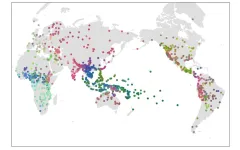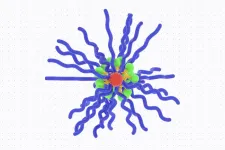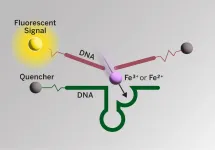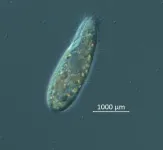(Press-News.org) The human body naturally produces opioid-like substances, such as endorphins, which block the perception of pain and increase the feeling of well-being. Similarly, opioid drugs, including morphine or fentanyl, are widely used for alleviating severe pain. However, their use is associated with a high risk of dependence and addiction, and their excessive misuse causes over 350,000 annual deaths worldwide. Researchers from the University of Geneva (UNIGE) have compared the action of natural and therapeutic opioids. The latter penetrate inside the cells to activate opioid receptors, whereas natural opioids are unable to enter cells and activate only receptors located on the cell surface. The location of the activated receptors could therefore explain why opioid drugs trigger very different physiological responses from those induced by natural opioids. The results, to read in Science Advances, could help to develop safer and more effective medications that better mimic natural opioids.
Opioids consist of a broad group of painkiller drugs, highly powerful but with potentially severe side-effects. The human organism’s response to these medications is governed by opioid receptors that belong to a large family of membrane receptors called GPCRs, which are present in all our cells and mediate a wide range of physiological functions, from vision and smell to brain function. Opioid drugs activate these receptors in neurons, thereby inducing signals that block the sensation of pain.
But why do the effects of different opioids vary? And why do they trigger so severe side-effects? “We had previously discovered that some opioids not only interact with receptors present at the surface of cells, but also have the ability to enter inside the cells to activate intracellular receptors,” summarises Miriam Stoeber, assistant professor in the Department of Cell Physiology and Metabolism at the UNIGE Faculty of Medicine, who led this research. “Does this have any implication on how the body reacts to natural and therapeutic opioids? This what we wanted to ascertain. Furthermore, as a third of all currently existing drugs target GPCRs, understanding the exact role of intracellular receptors could have very wide therapeutic implications.”
Localisation is crucial to defining a response
Taking advantage of new molecular tools they developed, the researchers studied the functioning of opioid receptors at unprecedented spatial resolution. “Instead of observing changes occurring at whole-cell scale, we were able to detail what happens at different locations inside the cells,” explain Arthur Radoux and Lucie Oberhauser, researchers in Miriam Stoeber’s laboratory and co-first authors of the study. “To do so, we developed biosensors that allowed us to detect in living cells whether receptors present at specific locations in or on the cells are activated and able to initiate a response.” Combining these new tools with analyses of gene expression and protein regulation, the scientists were able to demonstrate that the location of GPCRs activation modifies the response triggered by opioids, and consequently the signals involved in pain relief.
The key role of membrane lipids
In a second step, the researchers wanted to determine the mechanisms responsible for these different responses. “We focused specifically on membrane lipids, as recent research has shown that they can interact with certain signalling proteins and modify the responses receptors trigger,” clarifies Miriam Stoeber. And indeed, the types of lipids surrounding the GPCR influence the responses they transmit. This crucial role of lipids might also explain the variations in the effects of opioid drugs. “We hope now to discover if changes in membrane lipids occurring in metabolic diseases, such as diabetes, can influence the efficacy and the unwanted effects of GPCR drugs,” adds Miriam Stoeber.
The fact that the localization of receptors changes the cellular responses could explain differences of effects and side-effects triggered by natural and therapeutic opioids. “To confirm that hypothesis, we are planning in vivo experiments, with the ultimate aim to design better targeted therapeutics with improved efficacy and reduce side-effects,” concludes Miriam Stoeber.
END
How opioid drugs get into our cells
Unlike natural opioids, opioid drugs penetrate our cells, which explains both their high efficacy and their side effects, reveals a UNIGE team
2023-04-19
ELSE PRESS RELEASES FROM THIS DATE:
Grambank shows the diversity of the world's languages
2023-04-19
Linguists have long been interested in language variation. What are common or universal patterns across languages? What limits the possible variation between them? Grambank, the world's largest and most comprehensive database of language structure, enables researchers to answer some of these questions.
Grambank was constructed in an international collaboration between the Max Planck institutes in Leipzig and Nijmegen, the Australian National University, the University of Auckland, Harvard University, ...
Nanoparticles provoke immune response against tumors but avoid side effects
2023-04-19
CAMBRIDGE, MA — Cancer drugs that stimulate the body’s immune system to attack tumors are a promising way to treat many types of cancer. However, some of these drugs produce too much systemic inflammation when delivered intravenously, making them harmful to use in patients.
MIT researchers have now come up with a possible way to get around that obstacle. In a new study, they showed that when immunostimulatory prodrugs — inactive drugs that require activation in the body — are tuned for optimal activation timing, the drugs provoke the immune system to attack tumors without the side effects that occur when the ...
Informed by mechanics and computation, flexible bioelectronics can better conform to a curvy body
2023-04-19
MADISON – Today, foldable phones are ubiquitous. Now, using models that predict how well a flexible electronic device will conform to spherical surfaces, University of Wisconsin–Madison and University of Texas at Austin engineers could usher in a new era in which these bendy devices can integrate seamlessly with parts of the human body.
In the future, for example, a flexible bioelectronic artificial retina implanted in a person’s eyeball could help restore vision, or a smart contact lens could continuously sense glucose levels in ...
Killer heatwaves endanger India’s development
2023-04-19
Deadly heatwaves fuelled by climate change in 2022 made almost 90 percent of Indians more vulnerable to public health issues, food shortages and increased risks of death, a new study from researchers at the University of Cambridge reported in PLOS Climate.
India currently uses a national Climate Vulnerability Indicator (CVI) to measure climate vulnerability and make plans for adaptation. The CVI includes many different socioeconomic, biophysical, institutional, and infrastructural factors. But it doesn't ...
Newfound link between Alzheimer’s and iron could lead to new medical interventions
2023-04-19
There is a growing body of evidence that iron in the brain may play a role in Alzheimer’s disease. Lending weight to that idea, a new imaging probe has for the first time shown that in the same regions of the brain where the amyloid beta plaques associated with Alzheimer’s occur, there is also an increase in iron redox, meaning the iron in these regions is more reactive in the presence of oxygen. Their imaging probe could yield even more details about the causes of Alzheimer’s and help in the search for new drugs to treat it.
A ...
Scientists identify 2022 sea urchin killer
2023-04-19
TAMPA, Fla. (APRIL 19, 2023) – The search for the 2022 killer that decimated the long-spined sea urchin population in the Caribbean and along Florida’s east coast is over. A team of researchers organized by Mya Breitbart, Distinguished University Professor at the University of South Florida’s College of Marine Science, identified a single-celled organism called a ciliate as the cause of a massive die-off event to a marine animal vital to coral reef health.
Their findings were reported in Science Advances.
“We’re beyond ...
How the pandemic exacerbated racial inequalities in the US criminal legal system
2023-04-19
APRIL 19, 2023
As Covid roared through prisons in 2020, the U.S. prison population fell by as much as 30 percent, creating the largest, fastest reduction in prison population in American history. But this decarceration disproportionately benefited white incarcerated people, sharply increasing the fraction of incarcerated Black and Latino people. A new study in Nature shows that this increased racial disparity in U.S. prisons stems in large part from a long-standing problem with the justice system: Non-white people tend ...
MD Anderson Research Highlights for April 19, 2023
2023-04-19
HOUSTON ― The University of Texas MD Anderson Cancer Center’s Research Highlights showcases the latest breakthroughs in cancer care, research and prevention. These advances are made possible through seamless collaboration between MD Anderson’s world-leading clinicians and scientists, bringing discoveries from the lab to the clinic and back.
Recent developments include effective combination therapies for patients with BRAFV600E mutations, an approach to identify cancer biomarkers in extracellular vesicles, therapeutic strategies for improving ...
A once-stable glacier in Greenland is now rapidly disappearing
2023-04-19
COLUMBUS, Ohio – As climate change causes ocean temperatures to rise, one of Greenland’s previously most stable glaciers is now retreating at an unprecedented rate, according to a new study.
Led by researchers at The Ohio State University, a team found that between 2018 and 2021, Steenstrup Glacier in Greenland has retreated about 5 miles, thinned about 20%, doubled in the amount of ice it discharges into the ocean, and quadrupled in velocity. According to the study, such a rapid change is so extraordinary ...
The Container Store offers $10,000 in scholarships for Charisma Virtual Social Coaching
2023-04-19
The Container Store, the nation’s leading retailer of storage and organization solutions, custom spaces, and in-home organizing services, will fund $10,000 in scholarships for Charisma™ Virtual Social Coaching, a strengths-based social skills training developed by Center for BrainHealth.
Charisma is a personalized, avatar-driven program that provides real-time, unscripted social coaching in a safe, non-threatening virtual environment. Drawing on extensive cognitive neuroscience research, this program is demonstrated to help people with social challenges to ...
LAST 30 PRESS RELEASES:
Duke and Duke-NUS’ joint cross-population research to uncover "East-West" differences in disease and care
Scientists to ‘spy’ on cancer- immune cell interactions using quantum technology breakthrough
Tech savvy users have most digital concerns
Making lighter work of calculating fluid and heat flow
Normalizing blood sugar can halve heart attack risk
Lowering blood sugar cuts heart attack risk in people with prediabetes
Study links genetic variants to risk of blinding eye disease in premature infants
Non-opioid ‘pain sponge’ therapy halts cartilage degeneration and relieves chronic pain
AI can pick up cultural values by mimicking how kids learn
China’s ecological redlines offer fast track to 30 x 30 global conservation goal
Invisible indoor threats: emerging household contaminants and their growing risks to human health
Adding antibody treatment to chemo boosts outcomes for children with rare cancer
Germline pathogenic variants among women without a history of breast cancer
Tanning beds triple melanoma risk, potentially causing broad DNA damage
Unique bond identified as key to viral infection speed
Indoor tanning makes youthful skin much older on a genetic level
Mouse model sheds new light on the causes and potential solutions to human GI problems linked to muscular dystrophy
The Journal of Nuclear Medicine ahead-of-print tip sheet: December 12, 2025
Smarter tools for peering into the microscopic world
Applications open for funding to conduct research in the Kinsey Institute archives
Global measure underestimates the severity of food insecurity
Child survivors of critical illness are missing out on timely follow up care
Risk-based vs annual breast cancer screening / the WISDOM randomized clinical trial
University of Toronto launches Electric Vehicle Innovation Ontario to accelerate advanced EV technologies and build Canada’s innovation advantage
Early relapse predicts poor outcomes in aggressive blood cancer
American College of Lifestyle Medicine applauds two CMS models aligned with lifestyle medicine practice and reimbursement
Clinical trial finds cannabis use not a barrier to quitting nicotine vaping
Supplemental nutrition assistance program policies and food insecurity
Switching immune cells to “night mode” could limit damage after a heart attack, study suggests
URI-based Global RIghts Project report spotlights continued troubling trends in worldwide inhumane treatment
[Press-News.org] How opioid drugs get into our cellsUnlike natural opioids, opioid drugs penetrate our cells, which explains both their high efficacy and their side effects, reveals a UNIGE team





